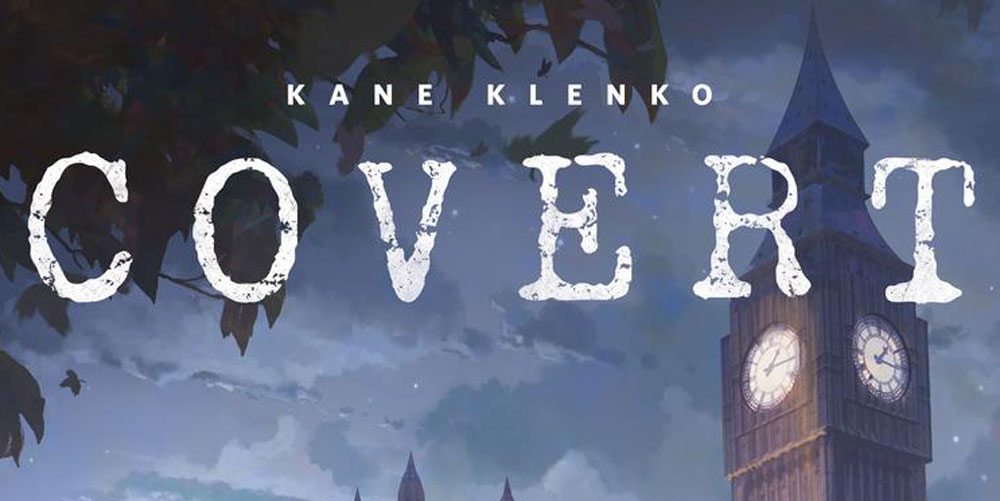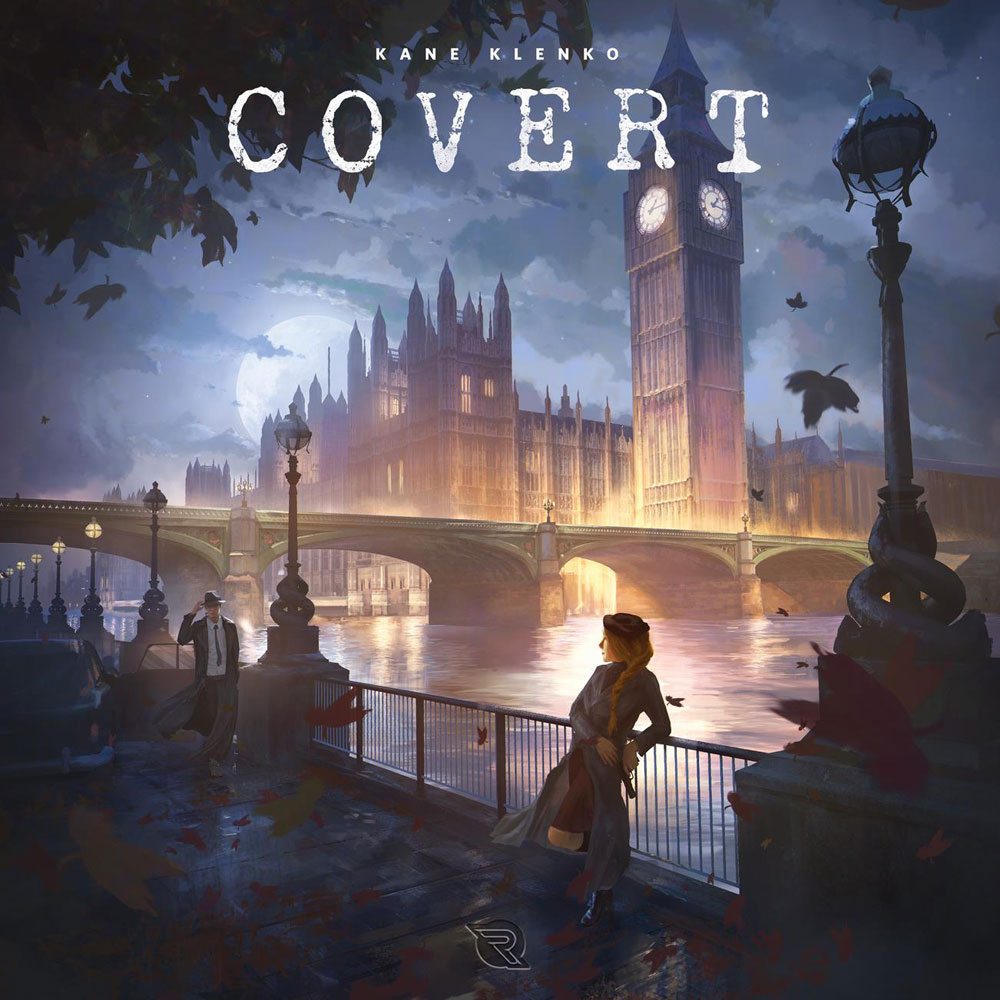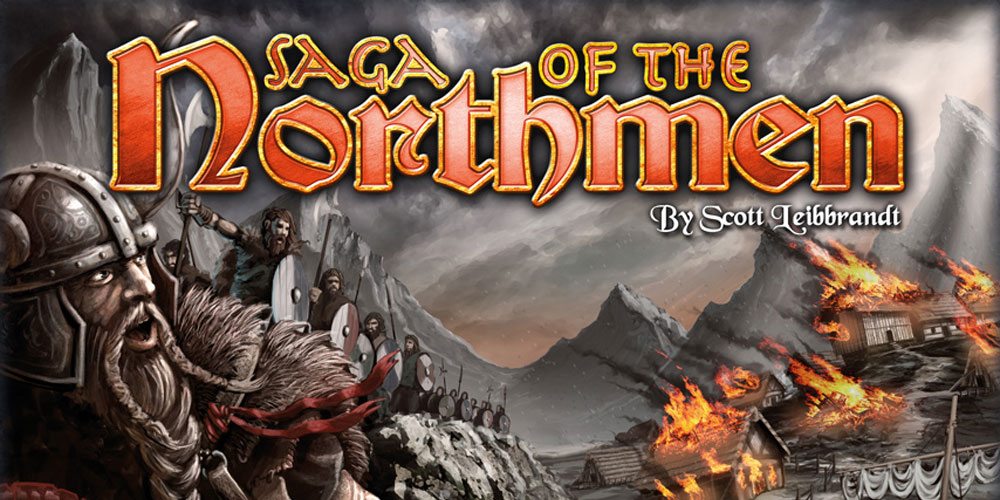Travel the world, acquire valuable assets and intel, and stick to the shadows. In this spy-themed game, you’re not out to kill enemy agents or blow things up—it’s all about being Covert.
At a glance: Covert is a game by Kane Klenko for 2 to 4 players, ages 10 and up, and takes 45-90 minutes to play (depending on number of players). It retails for $60 and is available now—check at your local game store, or order online. I think the age rating is probably fine as far as theme and content go, though the game can go a little long when players take a while to make decisions. The game is a combination of dice-placement and set collection, with a few other things thrown into the mix.
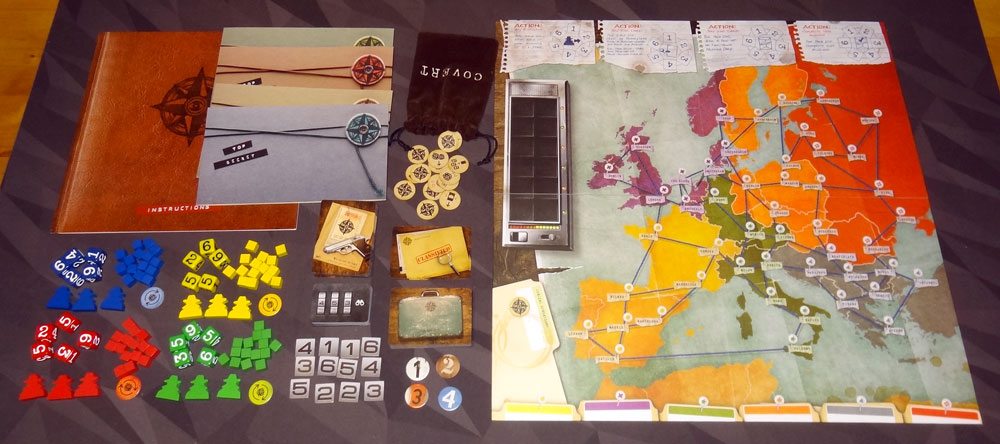
Components
- Game board
- 20 dice (5 each in 4 colors)
- 12 Agent pawns (3 each in 4 colors)
- 60 Intel cubes (15 each in 4 colors)
- 4 Reroll tokens (1 each in 4 colors)
- 48 Agency cards
- 60 Mission cards
- 6 Character cards
- 4 Player screens
- 4 Turn Order tokens
- 12 Cipher tokens
- 40 Code cards
- 16 Special Operations tokens
- Cloth bag

The components for Covert are mostly pretty nice, especially the look of it. I really like the aesthetic—the old-school spy gadgets like the big briefcase reel-to-reel tape recorder and the hidden device in the shoe heel. There are even little cryptograms and codes sprinkled here and there, like on the back of the rulebook and on the sides of the box.
The board has a little trouble unfolding flat—this may get better with repeated use, but it was a little stiff when new and I’m always a little afraid to correct that for fear of damaging something. One nice touch is that the boards and cards are designed with color blind players in mind, because not only are they different colors, but they also have different icons. However, the player pieces (dice, cubes, and agents) are not marked in any special way, so I don’t know if there would be any problem distinguishing the red and green pieces.
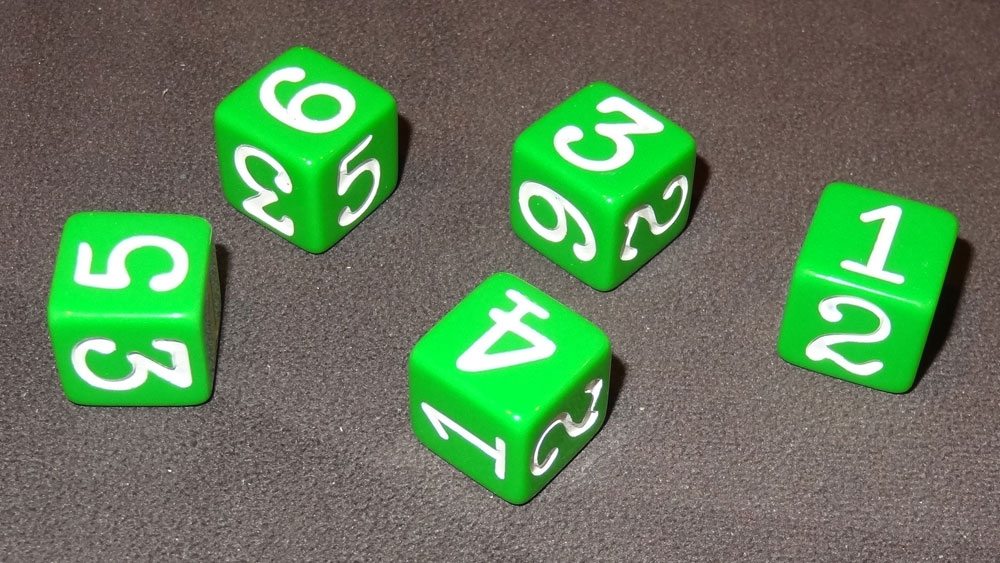
The dice are custom six-sided dice—nothing really fancy, but they’re engraved and painted with the same typewriter typeface that’s used throughout the game. Wooden pieces are fine: they’re silhouettes of a person with a turned-up collar and wide-brimmed hat.
The cloth bag is heavy velvet with a drawstring, with the Covert logo embroidered on it. Somebody joked to me that there must be a requirement somewhere for every Renegade Games title to include a cloth bag, so here it is. This one is used for the Special Operations tokens, which are put into the bag to mix them up.
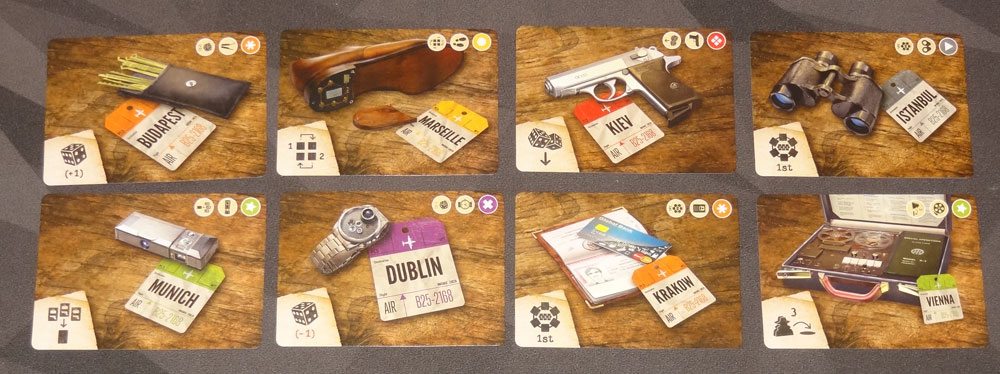
I really like the artwork on the Agency cards—each one has multiple uses, and there are index icons in the corner so that you can see information at a glance when fanning the cards in your hand. The one icon that sometimes confuses people is the tape reel—that’s for the reel-t0-reel recorder, but in places where you only see the icon, it’s easy to forget what you’re looking for because many people think it’s a film reel and are looking for a projector or movie camera. There is, however, a handy reference inside the player screen for all of the various icons.
How to Play
You can download a PDF of the rules here.
The goal of the game is to score the most points by completing missions and cracking codes. The game ends at the end of the round after any player has completed a sixth mission.
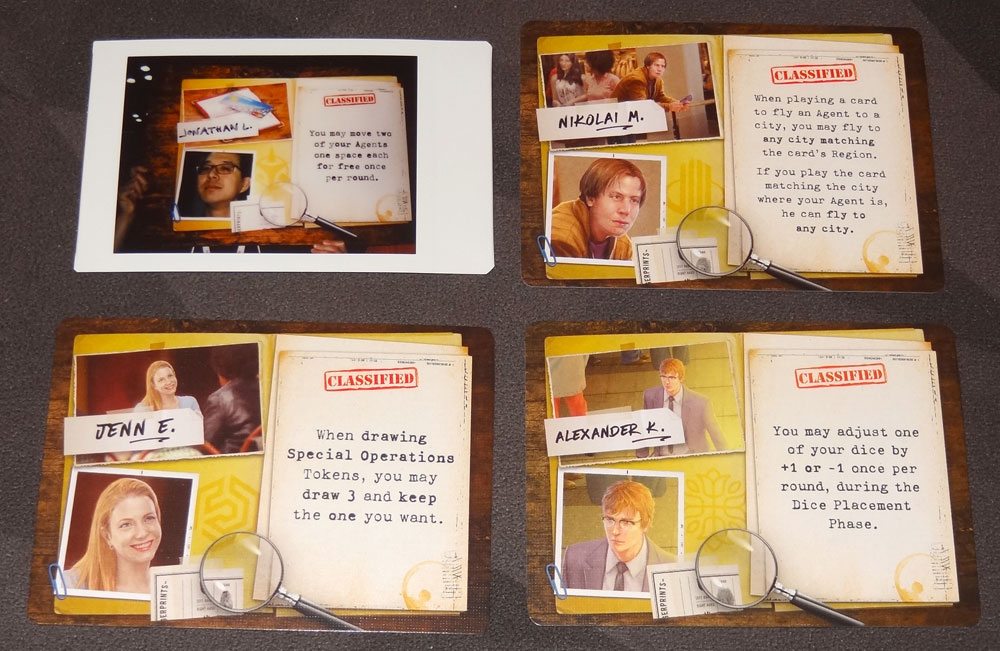
To set up, first give each player a set of pieces in their color: 5 dice, 3 agents, 15 intel cubes, a player shield, and a reroll token. In addition, each player gets a character card, which has a special ability on it. Shuffle the agency cards; each player draws three cards and places an agent in each matching city for their starting positions. (In a two-player game, you’ll also seed the map with 6 intel cubes in each of the unused colors.) Then reshuffle the agency cards, and deal each player 2 cards for their hands.

Six Agency cards are placed face-up at the bottom of the board in the region spaces. Note that the locations on the cards may not match the color of the region spaces. The rest of the cards form a deck nearby.
Shuffle the mission cards and deal three to each player—each player picks two to keep and returns the third to the bottom of the deck. Then place three mission cards face-up next to the board, with the deck nearby. Shuffle all the code cards and deal two to each player. Put the rest in two stacks near the board, equipment side up. Shuffle the cipher tokens and place them randomly on the board on the decoder grid. Place the turn tokens nearby—you’ll use one per player, and put the rest in the box. Put all the special operations tokens in the bag.
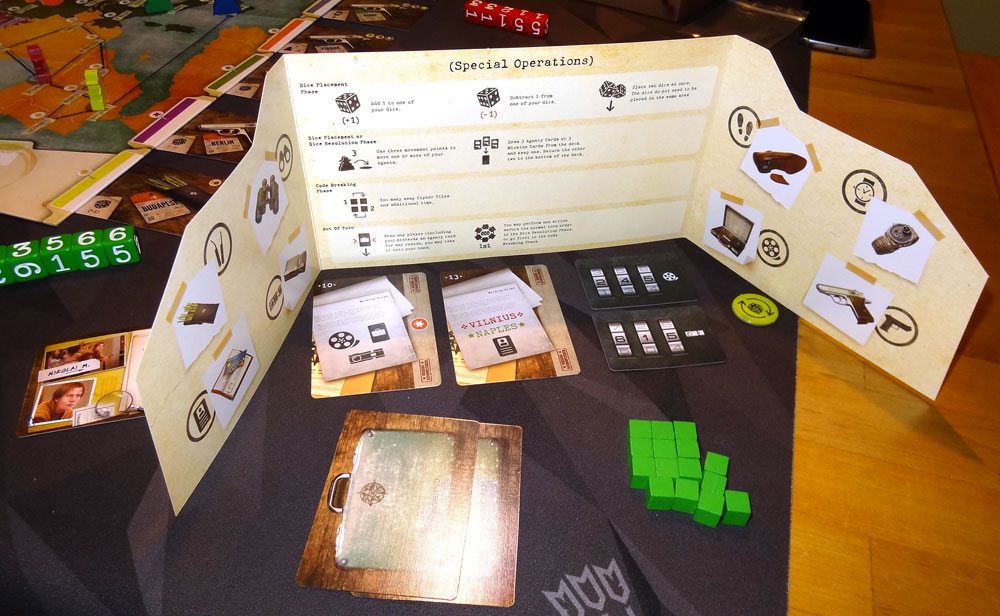
The game takes multiple rounds, and each round has three phases: Roll and Place Dice, Break Codes, Resolve Dice.
Roll and Place Dice: Everyone rolls all of their dice simultaneously and places their dice in front of their screens so all players can see them. You may use your reroll token once during the game to reroll any number of your dice. Then, starting with the last player from the previous round (or the start player in the first round) and going clockwise, players take turns clockwise placing one die at a time onto the action spaces, the special operations area, or the decoder.
When placing on an action space, if there are already any dice on the action circle you wish to use, you must place your dice adjacent to one of them, and they also must match the value shown on the board. For instance, in the photo below, if anyone wanted to place a die in the “Take One Card” circle, it must be a 1 or a 5 because there is already a 6 on the circle.

The special operations area is the folder near the bottom left corner of the board, marked with the special operations icon. Any value die may be placed here, and you immediately draw a special operations token from the bag and put it behind your screen. The token may be used on any future turn for its ability, and then returned to the bag.
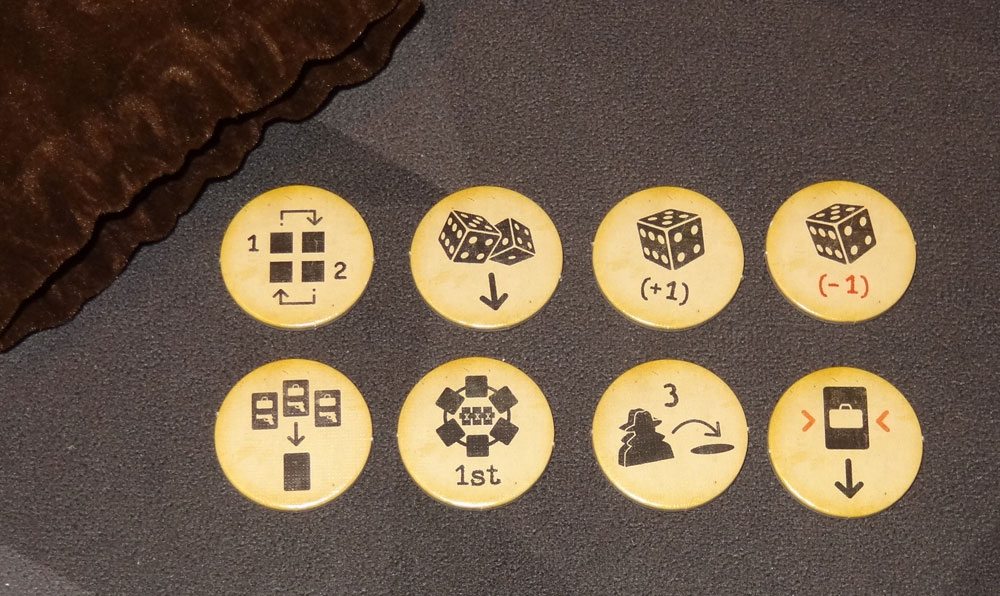
Special operations tokens may allow you to add or subtract 1 from a die, place two dice at a time, move an agent, get cards, take an early action, or get an extra swap during the Break Codes phase. (These actions are also available on the agency cards.) Sometimes you may need to place a die here because you simply don’t have any that can be placed in the action circles, but you don’t want to pass yet—at least you can get some special abilities, and maybe by the time it’s your turn again somebody will have filled in some spaces.
Dice placed on the decoder may be used in the Break Codes phase to override the number tiles.
If it’s your turn to place a die and you have no more dice or choose not to place any more, you take the turn order token with the lowest number, which indicates the order that players will break codes and resolve dice for the next two phases of the round. Once you’ve taken a turn order token, you may not place any more dice this round. After everyone has taken a turn order token, you proceed to the next phase.
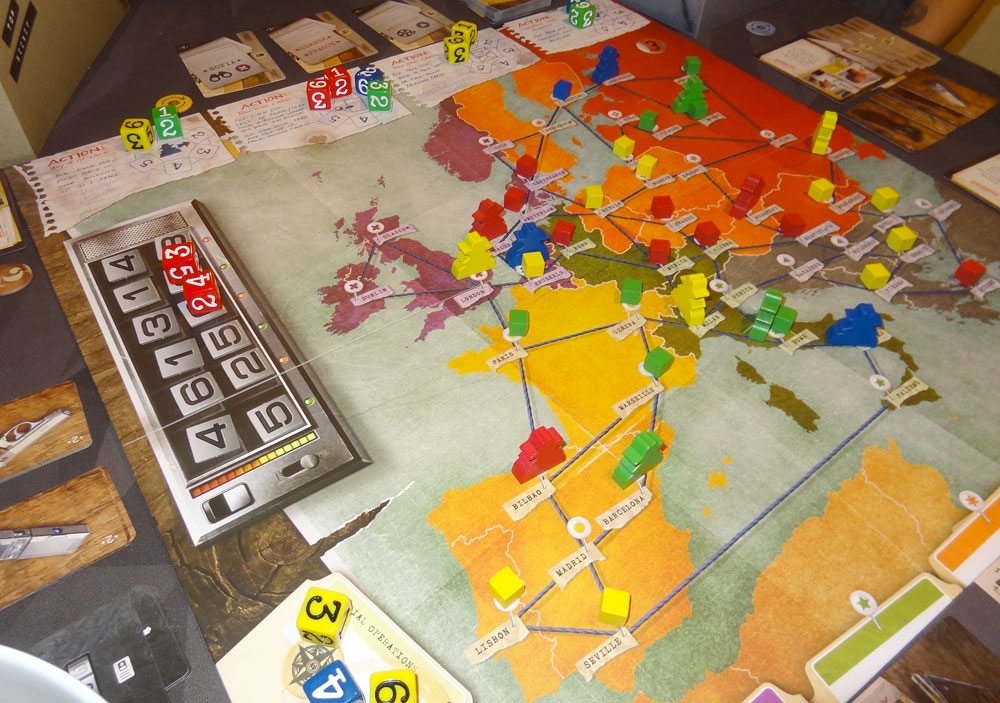
Break Codes: Following the turn order tokens, each player gets a chance to break codes. You are trying to arrange the tiles in the decoder area to match the three-digit codes on your code cards, which then unlocks them. You may perform one swap between two adjacent tiles, either in the same row or the same column. You may also swap the numbers on the ends of the same row. If you placed any of your dice in the decoder area, you may also place those on the decoder, temporarily changing a tile to the number shown on the die.

If you get the decoder to match your code cards, you reveal your code card, then turn it face-up and place it next to your character card (outside of your screen). An unlocked code card will reveal a piece of equipment, which may then be used to complete missions, or is worth 2 points at the end of the game if unused. Draw back up to 2 code cards, choosing from either deck.
After your turn, take back any dice you placed in the decoder area, whether you used them or not.

Resolve Dice: Following the turn order tokens, players take turns performing one action at a time by resolving the dice they have placed in the action area. You choose one of the action circles where you have dice, and then remove a die (or dice) from that circle to take the associated action.
Move Agents: Remove any number of dice from this circle—you may move 1 agent 1 space for each die removed. When you move, you put an intel cube on the space you just left (unless there is already a cube of your color there). If you move into a city that has intel cubes that are not yours, you may pick them up and place them on your character card. When you have two cubes of the same color, return them to that player, and then immediately take the agency card matching the region space where your agent is, or take the top card of the agency deck.

Take Agency Card: Remove a die from this circle, and then take an agency card from a region space matching the location of one of your agents. Or, remove two dice from this circle to take any of the agency cards or the top card of the deck. Alway refill the region spaces whenever cards are removed. You have a hand limit of 7 cards.
Cards show equipment, a city, and a special ability. Each card may be used for only one of these. Equipment is used to complete missions. You may discard an agency card on your turn to fly an agent to that city; this is a free action that does not require picking up a die. You may also discard a card from your hand to use its special ability, the same way you use special operations tokens.

Take Mission Card: Remove a die from this circle, and then take a new mission card—either one of the face-up cards, or the top of the deck. You may only have three active mission cards at a time, and must discard down to three if you have more.
Complete a Mission: Remove a die from this circle, and then complete one mission. Each mission card has two or three requirements, a mixture of equipment, cities, regions, or the agency card icon. You must have the right equipment and have agents in the listed cities or regions. If the mission card shows the agency card symbol, you must discard an additional agency card. The number in the top left corner of the card is the number of points the mission is worth.
Once completed, tuck the mission card under your character card so that the “Mission Accomplished” edge is visible. Some mission cards have either equipment or region icons on this edge—that means that you no longer need that type of equipment or agents in that region to satisfy equipment or city/region requirements for future missions.
Players continue taking one action per turn until all of the dice have been resolved. If nobody has completed six missions yet, then start a new round by rolling and placing dice again. If any player has completed six missions, the game end is triggered. Each player has the opportunity in turn order to complete one more mission card if possible, and then the game ends. (Special operations tokens and special abilities on cards may be used at this time.) The player with the highest score wins; ties go to the player with the most mission cards, and then the player with the single highest value mission card.
The Verdict
I’d first heard of Covert leading up to Gen Con last summer, and I got to play a brief demo of it with designer Kane Klenko. It made my Favorite Things About Gen Con list, too—and then things got crazy busy, I didn’t get a review copy right away, and it took a while before I was finally able to sit down and play it.

It’s an interesting mix of mechanics, some that seem familiar and some that feel new. What’s familiar is moving around on a board and getting to particular locations to acquire cards; having cards with multiple uses, including traveling to a particular city; and worker placement that dictates which actions you may take. But the way the worker placement happens—placing dice, and then removing them to take actions—feels a little different.
In most worker-placement games, one of the important strategies is placing your workers to prevent your opponents from taking certain actions. In this one, each action has up to six numbered spaces, so you can prevent somebody from taking a specific space by taking it yourself. But, because other dice have to be adjacent to those already placed, you can effectively prevent somebody from taking an action if you can place a die that makes their dice non-adjacent. For instance, if you look and see that your opponent has only 2s and 3s remaining, you can block an action by taking the 5 or 6 space. As long as nobody places the 1 or 4, that opponent is stuck.
The other difference is that you don’t take actions as you place the dice—you’re basically reserving the right to take that action later, during the dice resolution phase. The order matters—if you’re trying to maneuver your agent to a location so you can take a particular agency card, you’ll need to resolve the movement dice before the “take card” die … but you don’t have to place them in that order. Or, if you think somebody is after a particular mission card, you might be able to take it before they do, even if they placed their “take mission card” die before you did. This aspect of the game, the fact that the placement of the dice and the resolution of the dice can be time-shifted, can be a little tricky to grasp at first, but opens up some interesting strategies.
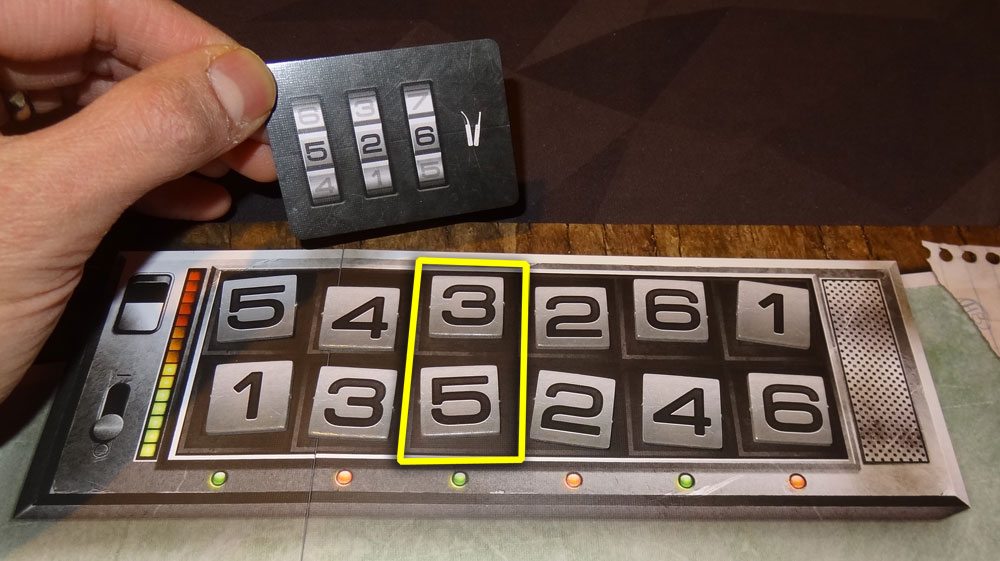
The code-breaking part of the game is a fun element that adds to the spy theme. It’s not absolutely required to break any codes at all, but it can be helpful if your code cards are for equipment that you need for a particular mission. Or, if you happen to see that the decoder is pretty close to your codes, then it can’t hurt to crack your codes because unused equipment is still worth 2 points. Since each player only gets to make 1 swap in the decoder (barring special abilities), the code-breaking phase is usually fairly quick; either you can make a match or you can’t. For some players, this part of the game can feel a little disconnected, but I enjoyed it—maybe because I liked the puzzle of getting my numbers unlocked.
One thematic element I particularly liked, even though it’s a relatively small part of the game, is the intel cubes. As you move around the board, you leave intel cubes behind—other players can pick these up (while leaving behind their own) and cash them in for agency cards. I like that, as covert as you are, you still leave behind some evidence of your passing, which benefits the other spies when they discover it.
The mission cards allow for a couple approaches: you can try to go for the big points, or you can try to build up the bonus icons that will make future missions easier to complete, as long as you can find missions where those bonus icons apply. Since the game ends after six missions, though, you have to pace yourself either way.
The one complaint that I have is that the game can drag a little bit, particularly when everyone is still learning it, so if you’ve got folks who are prone to analysis paralysis you’ll want to estimate a bit more time. It feels like ideally a game that should be about an hour or so, but with four players it can sometimes be two hours instead. That said, I think once all players are familiar with the game, it would go faster—my particular situation is that I’m always teaching new players new games.
It’s worth noting that Covert doesn’t have any fighting. Despite the guns, there is no killing, no area control: all of the agents are working in secret, getting into position and obtaining the requisite equipment. If you’re looking to play a game that feels like watching Jason Bourne, this is not the game for you. However, if you like the idea of racing to complete missions and gathering intel, then Covert can scratch that itch.
For more information about Covert, visit the Renegade Games website. Covert is available from Amazon.
Disclosure: I received a review copy of this game.
